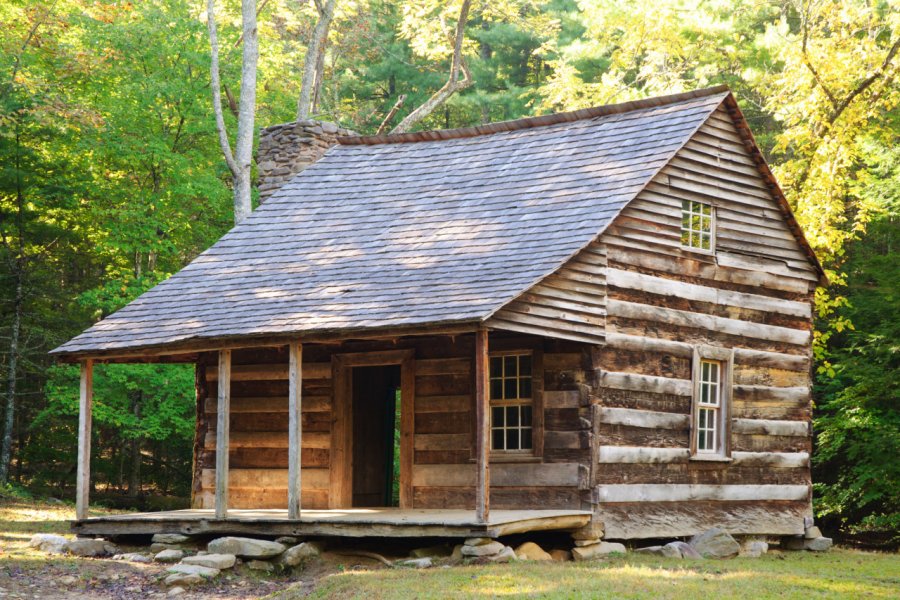Travel Guide Great Smoky Mountains National Park (Tn)
Find an accommodation
Advertising
The Great Smoky Mountains National Park straddles Tennessee and North Carolina. Its surface area of 2,110 km2 makes it one of the largest protected areas in the eastern United States. It encompasses the ridges of the Great Smoky Mountains which are part of the Blue Ridge Mountains and is crossed through by the Appalachian Trail. With more than 10 million visitors per year, it is the most visited national park in the United States to date. GeologyGeologists have identified more than twenty types of rocks in the park, most of which are sedimentary. The oldest ones date from 545 to 800 million years ago. The erection of a very high mountain range between 310 and 245 million years ago following the collision of two tectonic plates caused the massive rejection of metamorphic rocks, such as sandstone, shale, quartzite and slate, which are the main rocks of the park. Similarly, at the margins of these two plates, volcano eruptions have occurred, releasing eruptive rocks to the surface. Erosion caused by ice, wind and water has, over the millennia, cleared the most resistant layers to form the highest peaks of the Great Smoky Mountains, such as the hard metasandstone at the top of the Clingmans Dome. The same is true of most of the park's beautiful waterfalls, where streams have encountered very resistant edges of metasandstone that erode more slowly than slate or metasiltstone. The oldest metamorphic granite and gneiss rocks near Bryson City, Ela and Cherokee are the oldest in the park.HistoryWell before the first pioneers came to occupy their slopes, the Great Smoky Mountains were already known to the Cherokee Indians. They called it sha-kon-o-hey (the land of blue smoke) because of the blue mist that constantly floats on the horizon. In 1831, President Andrew Jackson signed the Indian Removal Act, which contributed to the gradual expulsion of Indian tribes east of the Mississippi to what is now Oklahoma. After the Treaty of New Echoa, signed in 1835 by the Cherokees, the majority of them were forcibly deported in 1838-1839. Some, guided by the traditionalist Tsali, took refuge in the Great Smoky Mountains. Today, most of their descendants live in the Qualla Boundary Reserve, located south of the park on the North Carolina side. After the Europeans settled, the timber industry flourished, to such an extent that at the end of the 19th century a train line, the Little River Railroad, was built for transport from remote areas. Very quickly, the landscape began to empty of its trees and the reactions of locals and visitors to preserve the region were not long in coming. As the federal state did not have enough land, the creation of the park, although authorized by Congress in 1926, took time to come into being. It was with the help of substantial private funds ($5 million was donated by John Rockefeller Jr.), added to the $2 million provided by the United States government, and with a significant mobilization of the residents of Tennessee and North Carolina, that the park was created on June 15, 1934. It was finally inaugurated by President Franklin Roosevelt on September 2, 1940. Declared a Biosphere Reserve in 1976, Great Smoky Mountains Park was inscribed on UNESCO's World Heritage List in 1983.Climate Almost the entire park has a humid continental climate, similar to that found much further north in the United States, which differs from the nearby plains which have a humid subtropical climate. Temperatures in January average 5.5°C and in July 26.6°C. The average annual temperature is 15°C. Rainfall is high and varies according to altitude. In the valleys, it reaches 1,400 mm, but can reach up to 2,200 mm on the peaks.NatureDifferences in altitude, abundant precipitation and forest (one of the largest temperate primary hardwood forest areas in North America) give the park an unusual richness of the biotope. 95% wooded, it is home to more than 100 species of trees. The lower regions are dominated by deciduous forests while the upper areas are populated by conifers. Spruces, firs and rowan trees cover the peaks. In addition, the park has more than 5,400 plant species, including more than 1,400 flower species, including 30 varieties of orchids and anserins. There are more than 200 bird species, 66 mammal species (including more than 1,500 protected black bears), 50 fish species, 43 amphibians and 39 reptiles. Since 2001, the park has been trying to reintroduce elk, a large deer.
What to visit Great Smoky Mountains National Park (Tn)?
Suggested addresses Great Smoky Mountains National Park (Tn)
Weather at the moment
Advertising
Organize your trip with our partners Great Smoky Mountains National Park (Tn)
Transportation
Book your plane tickets
Car Rental
Boat rental
Accommodation & stays
Find a hotel
Holiday rental
Find your campsite
Tailor-made trip
Immersion travel
Services / On site
Activities & visits
Find a doctor
Great Smoky Mountains National Park (Tn) travel inspiration
Find unique Stay Offers with our Partners
Pictures and images Great Smoky Mountains National Park (Tn)
There are currently no photos for this destination.










